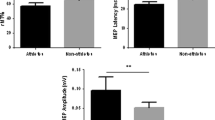Abstract.
While it is known that relatively rapid changes in functional representation may occur in the human sensorimotor cortex in short-term motor-learning studies, there have been few studies of changes in organisation of the corticomotor system associated with the long-term acquisition of motor skills. In the present study, we have used transcranial magnetic stimulation (TMS) to investigate the corticomotor projection to the hand in a group of elite racquet players, who have developed and maintained a high level of skill over a period of many years, and have compared the findings with those in a group of social players and a group of non-playing control subjects. Increased motor-evoked-potential (MEP) amplitudes and shifts in the cortical motor maps for the playing hand were found in all of the elite players and cortical motor thresholds were reduced in some players, whereas in the social players all parameters were within the normal range. The findings in the elite players are interpreted as being indications of a process of functional reorganisation with the motor cortex or corticomotor pathway that are associated with the acquisition and retention of complex motor skills.
Similar content being viewed by others
Author information
Authors and Affiliations
Additional information
Electronic Publication
Rights and permissions
About this article
Cite this article
Pearce, A., Thickbroom, G., Byrnes, M. et al. Functional reorganisation of the corticomotor projection to the hand in skilled racquet players. Exp Brain Res 130, 238–243 (2000). https://doi.org/10.1007/s002219900236
Received:
Accepted:
Issue Date:
DOI: https://doi.org/10.1007/s002219900236




